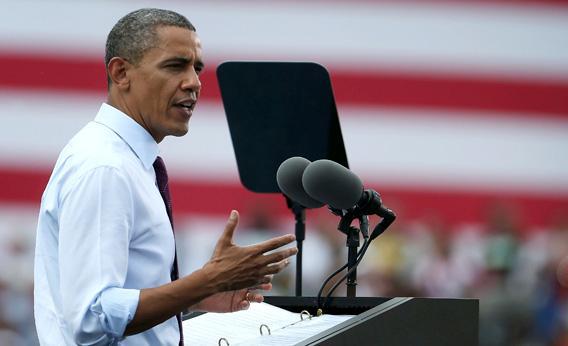Presidential candidates tweet, text, email, post to Facebook with the frequency of randy 18-year-olds, upload videos to YouTube and Vimeo, develop apps, hold virtual town halls, and get asked anything on Reddit.
But then the hour comes for the Big Speech, the most important moment of the campaign, and they walk behind a podium, stare into a TV camera, and read (and read and read) a prepared text from a teleprompter.
We live in a golden age of public events, a time when speakers are inventing all kinds of wonderful new ways to connect with audiences. From TED talks to Apple product rollouts to televangelical sermons, speakers are exploiting all media—music, video, photographs, PowerPoint presentations, social networks, live feedback—to give their message visual bang and intellectual clarity. Better wireless microphones liberate speakers to move, to walk up to—even mingle with—their audience.
Yet political speeches remain frozen in amber, as dull as Franklin Pierce. The political speech—especially the major political address like the State of the Union or the nomination acceptance—is a form that hasn’t progressed since the dawn of TV and has barely evolved since 19th-century candidates stumped on front porches. This year’s campaign has, if anything, been worse than ever. The full extent of oratorical experimentation: Mitt Romney has used a whiteboard to explain Medicare.
It doesn’t have to be this way. A case study: When he was vice president and a presidential candidate, Al Gore was as dreary a speaker as they come—wooden, static, a lock box. But after his defeat in 2000, Gore delivered what is arguably the most famous and effective political speech of our age, An Inconvenient Truth. Gore didn’t suddenly become a better orator. Rather, he embraced modern media. He created a Keynote presentation incorporating charts, TV clips, animation, and then gave it casually and without a podium.
TED has advanced the form even more. Hans Rosling’s TED talk is a perfect marriage of speech and visual statistics. Lior Zoref brought a live ox onstage for his TED talk, then conducted an experiment in the wisdom of crowds by having the entire audience guess its weight. Even Bill Gates, a legendarily bad speaker, dazzled a TED crowd with a casually delivered speech featuring a couple of photos, a few charts, and one superb prop—a jar of mosquitoes. This rhetorical creativity appears to be everywhere but in politics. Andy Stanley, the boyish megachurch pastor, does wonders walking around a stage, talking informally, and pointing occasionally to relevant quotes flashed on the TV next to him. Steve Jobs’ product launches married technology, enthusiasm, and informality to create transcendent experiences for his audiences. Watch his legendary 2007 introduction of the iPhone, in which Jobs travels the stage, demonstrates the product, explains a few charts, and uses a huge video screen to illustrate what he’s talking about. It’s not magic. Jobs merely used the media we already have to create a rich, emotional experience for the audience.
It’s easy to apply these principles to a convention acceptance speech or a State of the Union. On Thursday night, for example, President Obama should move around the grand stage in Charlotte, not imprison himself at the podium. When he talks about a voter he met on the trail, convention-goers and TV viewers should see a huge picture of her displayed behind him, or—better yet—a brief video about her. When Obama runs through his accomplishments as president, the DNC should show us a montage of images (split screen for the viewers at home): the situation room photo on the day Osama Bin Laden was killed, a reopened auto plant, a confirmed Justice Sonia Sotomayor. And if the campaign is feeling really frisky, they could even try scoring his speech with heart-swelling music. (It sure worked in The American President.)
In late October, if one campaign or the other is desperate and all seems lost, they should remember the most effective rhetorical strategy of all: Give a speech while riding back and forth on a horse. (Romney could even borrow Rafalca from Ann.)
